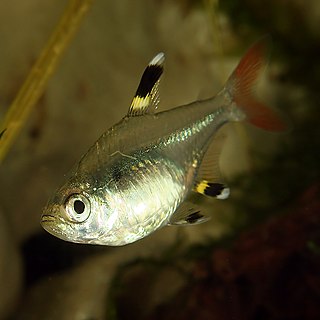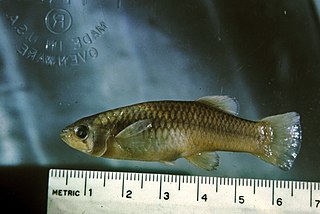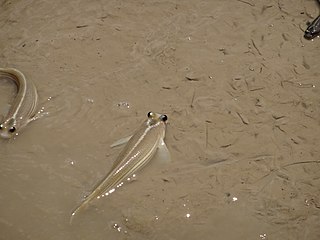
Cyprinodontiformes is an order of ray-finned fish, comprising mostly small, freshwater fish. Many popular aquarium fish, such as killifish and live-bearers, are included. They are closely related to the Atheriniformes and are occasionally included with them. A colloquial term for the order as a whole is toothcarps, though they are not actually close relatives of the true carps – the latter belong to the superorder Ostariophysi, while the toothcarps are Acanthopterygii.

Poecilia is a genus of fishes in the family Poeciliidae of the order Cyprinodontiformes. These livebearers are native to fresh, brackish and salt water in the Americas, and some species in the genus are euryhaline. A few have adapted to living in waters that contain high levels of toxic hydrogen sulfide and a population of P. mexicana lives in caves.

Hyphessobrycon is a genus of freshwater fish in the family Characidae. These species are among the fishes known as tetras. The genus is distributed in the Neotropical realm from southern Mexico to Río de la Plata in Argentina. Many of these species are native to South America; about six species are from Central America and a single species, H. compressus is from southern Mexico.

Astyanax is a genus of freshwater fish in the family Characidae of the order Characiformes. Some of these fish, like many of their relatives, are kept as aquarium pets and known collectively as tetras. With around 150 described species and new ones being described yearly, this genus is among the largest of the entire order; Hyphessobrycon also has more than 145 species and which one is larger at any one time depends on whether more species have been recently described in one or the other. The blind and colorless cave tetra of Mexico is a famous member of the genus, but its taxonomic position is disputed: Some recognize it as part of the Mexican tetra and this is supported by phylogenetic evidence, but others recognize the cave form as a separate species, A. jordani.

Anablepidae is a family of fishes which live in brackish and freshwater habitats from southern Mexico to southern South America. There are three genera with sixteen species: the four-eyed fishes, the onesided livebearers and the white-eye, Oxyzygonectes dovii. Fish of this family eat mostly insects and other invertebrates.

The four-eyed fishes are a genus, Anableps, of fishes in the family Anablepidae. They have eyes raised above the top of the head and divided in two different parts, so that they can see below and above the water surface at the same time.

Pristella is a genus of fish in the family Characidae. It was formerly a monotypic taxon only containing Pristella maxillaris, but in 2019 a second species, Pristella ariporo, was described.

The Big Bend gambusia is a rare species of fish in the family Poeciliidae. It is endemic to the Big Bend region of the Rio Grande of the United States and Mexico. The only known remaining population is in a protected pond in the Big Bend National Park.

Micropoecilia is a genus of poeciliids native to fresh and brackish water from the Amazon Basin to Trinidad. While recognized as valid by FishBase, others have considered this genus as being synonymous with Poecilia.
Carlhubbsia is a genus of poeciliids native to Guatemala and Mexico. The name of this genus honours the American ichthyologist Carl Leavitt Hubbs (1894-1979) who originally named the genus Allophallus, a name which was preoccupied by a genus of Diptera.

Cnesterodon is a genus of poeciliids native to South America.

Austrolebias is a genus of killifish in the family Rivulidae. These annual killifish live in temporary pools, swamps and streams in the Río de la Plata, Patos–Mirim and Mamoré basins in South America.

Spectrolebias is a genus of killifish in the family Rivulidae. These annual killifish are endemic to seasonal waters in the Paraguay, Tocantins–Araguaia, Xingu and Mamoré–Grande basins in Bolivia, Brazil and Paraguay. Each species generally has a small distribution and some are seriously threatened by habitat loss; the entire known range of S. reticulatus is in the area flooded by the Belo Monte Dam.

Jenynsia multidentata is a species of killifish from the family Anablepidae. It is a viviparous, benthopelagic species in the genus Jenynsia. They are onesided livebearers with a clear asymmetry of the males' genitalia. With onset of maturity, the anal fin of male fish develops into a gonopodium which can be brought forward on one side only. Based on the bending to the left or to the right of the tip of the gonopodium, two morphs of male fish can be distinguished.
Alfaro huberi is a species of livebearer in the family Poeciliidae, in the New World subfamily Poeciliinae. It is found in clear, fast flowing streams in Central America where it has been recorded from Honduras, Guatemala and Nicaragua. This fish was formally described in 1923 as Priapichthys huberi by Henry Weed Fowler with the type locality given as Marceligo Creek which is a tributary of the Río Tunky at Miranda in Nicaragua. The specific name honours the Curator of Mammals at the Academy of Natural Sciences of Philadelphia Wharton Huber (1877-1942), a colleague of Fowlers, who collected the type.
Stanley Howard Weitzman was a Research Scientist Emeritus at Division of Fishes, National Museum of Natural History, Washington, D.C.

The finescaled four-eyed fish is a species of four-eyed fish found in coastal waters of the Atlantic Ocean from Trinidad and Tobago down to southeastern Brazil. They mostly inhabit brackish environments such as estuaries, mangrove swamps, and tidal mudflats. It grows to approximately 30 cm (12 in) in length.
Pristella ariporo is a freshwater fish in the family Characidae of the order Characiformes. It is a tropical fish. It resides in the basin of the Orinoco in Colombia.

Astyanax abramis is a small freshwater fish from the inland rivers of South America. It is plentiful in almost the entire continent, with a habitat including the La Plata, upper Amazon, and Meta River basins. The body shape is subrhomboidal and laterally compressed, and the scales are largely silver, with a blue or green tint on the dorsal side.
















